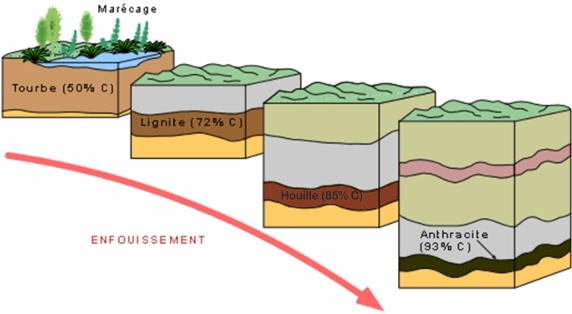|
Introduction :
At the end of the primary era, when the climate was wet and warm on Earth, the successive burial of forests has led, over the milleniums, to the formation of coal. Yet this coal may be found at different maturation stages: peat, lignite, coal and anthracite.
Different types of coal :
The decomposition of plant debris away from the air marks the beginning of the coal formation. For it to take place, it is necessary that a large amount of plant debris accumulates in a shallow layer of water and that the environment has a low quantity of oxygen and / or that the burial procees happens fast to reduce the oxidation.
During burial, the decaying plant matter suffers an increase of temperature and pressure; it settles, loses water, it enriches of carbon and is gradually transformed into rock under the effect of the carbonification also called coalification or carbonization.
The gradual transformation of plant remains produces coals more sophisticated each time that we can distinguish according to their carbon percentage. Plant residues are first transformed into peat (up to 50% carbon), then into lignite (65 to 75% carbon), then into coal (80 to 90% carbon) and finally into anthracite (92 to 95% carbon).

The higher the coal is, the higher the percentage of carbon, and the remains of plants are the less recognizable.
Reminder on "Earthcaches": There is no container or logbook on the given coordinates. Just visit the site and answer the questions by e-mail.There is no need to wait for my reply, feel free to log immediately after. If the answers are incorrect, I will let you know. Happy caching!
To validate your visit:
1-. What is the average temperature increase every 30 meters in depth?
2-. What type of coal is the most exploited? Why?
3-. Observe the coal samples presented here, what difference do you see between the anthracite and the rest of the blocks?
4-. What size is the lignite block?
You can contact me in: English, French or Spanish.
|